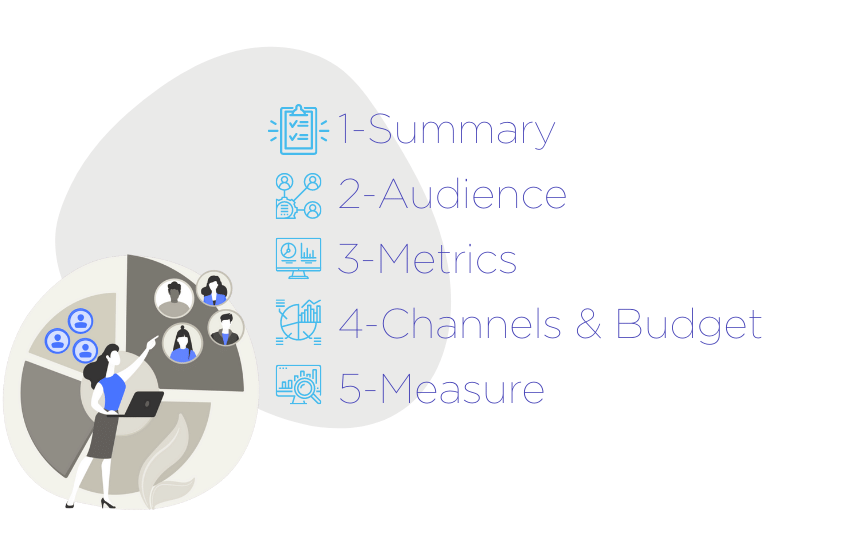How to Build a Marketing Plan
Marketing plans represent a significant and dynamic part of your overall business strategy. Your organization relies on them to identify and attract potential customers, retain existing clients and measure results.
Marketing plans are also essential for designing a blueprint for marketing activities — which channels you use, to whom you advertise and when.
Learn more about how to design and execute an effective marketing plan below.
What is a marketing plan?
A marketing plan is a document spelling out the audience, goals and budget for advertising. Each one details the campaigns, timelines and key analytics of specific marketing goals.
Types of marketing plans
Some businesses design their programs around types of advertising or channels. For example, an online retailer will have a digital commerce marketing plan. They may also have different strategies for email marketing, social media advertising and content marketing.
Other companies segregate their strategies by goals or campaigns, such as running an internet marketing campaign for a defined period to build brand awareness.
Elements of a marketing plan
Your business is unique, and it needs a distinctive marketing strategy to set it apart. As you begin to strategize, your plan should include:
- Market research to indicate where you stand, industry benchmarks and more.
- A strengths, weaknesses, threats and opportunities (SWOT) analysis.
- Buyer personas to understand your target market better.
- The fundamentals — product, price, promotion, people and placement.
- Established goals and a way to gauge progress toward them.
How to write a marketing plan?
Successful advertising roadmaps don’t have to be complex — even a simple marketing plan works, provided it covers the basics. A quick Google search offers many free marketing plan templates that can serve as a launching point for your customized strategy. You can also follow the tips below to create a plan of your own.

1. Start with what you know
Write out a brief summary of your business and its purpose. Describe your product or service, what makes it unique and why you’re a better choice than the competition. These are points to focus on in your advertising, no matter which channel you choose. These points also set the foundation for your SWOT analysis and market research.
2. Define your audience and set your goals
The next is deciding with whom you want to communicate. Determine whether your campaign is targeting prospective customers for lead generation or existing ones to build loyalty.
Personalization is essential in successful digital marketing efforts since people are more likely to open a personalized message or email. Segmentation also allows your business to take advantage of audience targeting — exposing your advertising to a certain demographic based on characteristics such as age and lifestyle interests.
3. Identify your metrics
After you know who your target audience is and what you want them to do, it’s time to define success. Determine which metrics are valuable for information to provide the insights your business needs — those categories will change depending on the goals you established in step two.
It’s important to know how to interpret and understand the data and the “averages” to gauge performance. For example, the average email click-through rate (CTR) is 2.44%. Seeing a jump to 5% indicates your emails are outperforming the norms.
4. Choose your channels and set your budget
Next up — figuring out where to find your audience. A video game manufacturer advertising to teenage boys should use different channels than a skincare company for Gen X women. One might use video ads while the other might use guest posting. Choose the one delivering the best results for your investment — whether it’s pay-per-click (PPC) marketing or SEO-powered sales copy.
5. Measure your results
One primary benefit to digital marketing is the availability of real-time metrics. This convenience allows you to monitor your efforts’ effectiveness and make adjustments quickly. Most social media platforms offer detailed analytics to track important data, as do search engine providers like Google and Microsoft.
It’s also a good idea to do a SWOT analysis to improve your marketing plan and strategies.
Marketing plan examples
Now that you know what a marketing plan entails and how to develop one, let’s walk through a simple marketing plan for a fictitious business.
Frank’s All-Natural Cat Treats (FACT) is an online retailer shipping feline deliciousness throughout the country. Their mission is to make house cats happier and healthier through better-quality treats. They handcraft each batch in their commercial kitchen and ship the same day to ensure freshness.
The natural audience for FACT is cat owners, and the company would like to expand brand awareness within its market — millennial feline parents who will spend more for higher quality products. FACT has examined essential digital marketing metrics and determined social media followers and new website users are measures they want to track.
FACT decides to advertise on YouTube, Instagram, Facebook, Twitter and Pinterest to increase social media followers. They plan to use short video clips of happy felines to highlight how much cats love their treats. Driving traffic to their website is key to achieving their new visitor goal, and they’ve written several PPC ads for keyword searches they want to target. They’ve set an overall budget to move funds between channels where they see the best results.
After starting their campaign, FACT checks their analytics and sees a significant increase in Instagram and Twitter followers. Their PPC ads haven’t performed as well, but Pinterest ads have driven a lot of website traffic. As a result, FACT scaled back on Facebook and YouTube advertising, reinvested funds into other platforms and made some adjustments to their PPC bidding strategy.
Google Maps SEO: 10 Tips to Rank Higher on Google Maps
What is Google Maps SEO? Google Maps SEO (search engine optimization) is the process of making your business visible on Google Maps when users search for related keywords to your business. As an internet user, you have likely done a Google search to find a local store selling the product you’re looking for near you. […]
Read moreHow To Check Google Ranking?
Learning how to check Google ranking lets you know how much exposure your website receives for specific keywords. Checking your website’s Google ranking may help you identify areas of strengths and weaknesses you can improve on to rank higher on the SERPs and boost your return on investment (ROI). Read on for more information about […]
Read moreWhat Is Google EEAT and How To Optimize Your Site?
Over the years, digital marketers have determined the key elements that produce a high-ranking webpage. But little is known about the Google algorithm that puts webpages at the top of the SERP. However, Google has provided helpful guidelines to ensure quality pages match user intent. Explore what Google EEAT is and what you can do […]
Read moreHow To Add Google Analytics to WordPress?
Google Analytics is one of the most efficient web analytics tools offered by Google for businesses and individuals who want statistics on a specific website’s performance. Further to this, it provides you as the site owner with data on visitor insights such as how they access the site, the channels they use, top keywords used to […]
Read more
